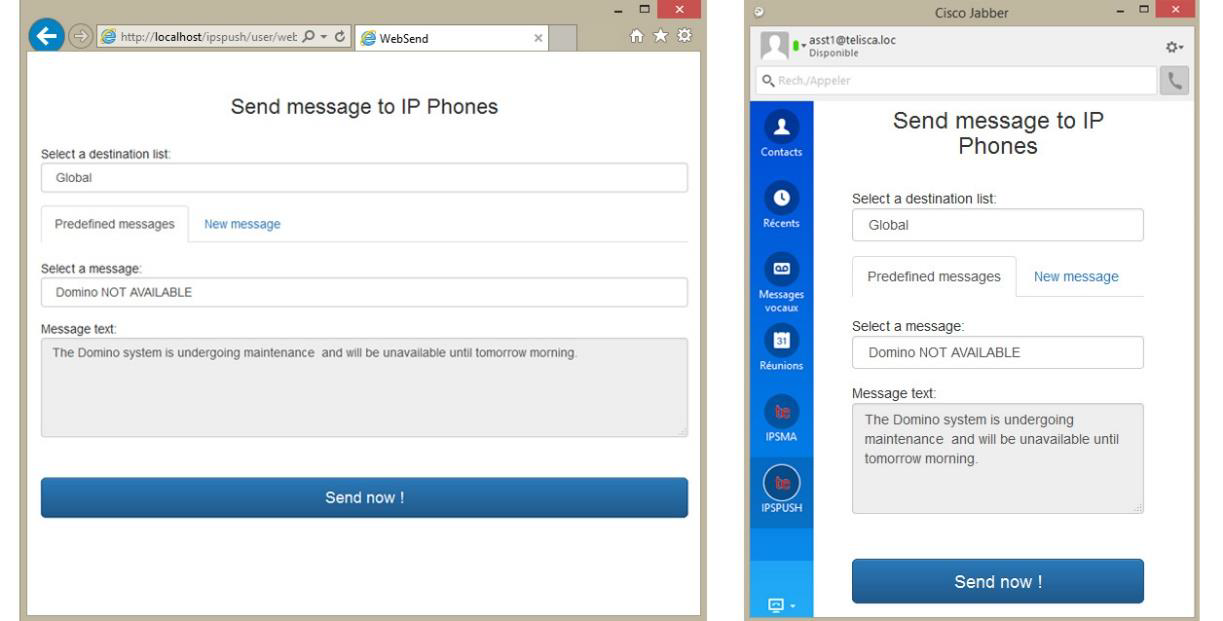Imagicle EN Page Alert
Overview
Imagicle EN Page Alert is the ideal solution to broadcast text messages, presentations (several graphic or text slides) or play audio announcements to a large group of Cisco IP Phone users or from user to user.
Pre-defined text messages may be sent from an IP Phone service or from a web interface (optionally embedded into Jabber clients). Depending of own profile, the user can leverage predefined distribution lists or send to predefined phone numbers; user may also send predefined messages or enter a new message.
Priority messages are pushed with an audio notification and can clear after a while. Information messages or presentations may remain available for reading afterward, through Services menu.
Audio announcement can be live sent (push to talk) from an IP Phones or from a recorded audio file or Text to Speech to a list of IP Phones . Audio announcements are sent from one IP Phone or from Pager Alert server to a group of IP Phones, using multicast IP technology which reduce the bandwidth required. The audio announcement is played on the IP Phone’s loudspeaker or, if the user is on a conversation, on the phone handset. Audio level can be forced depending on alert priority. It is also possible to broadcast to external IP-based speakers.
Text messages or audio announcements can be sent from the IP Phone XML interface, a full screen web interface including a graphic map, a Jabber custom tab, a third party application (REST API) or automatically based on schedule, taking into account the working hours of each IP phone owner.
User Interfaces
Message transmission may be triggered via a web interface, from a Jabber clients or from IP Phones, protected by credentials or by AD/LDAP security group. According to the profile, users may access pre-defined distribution lists and pre-defined messages. The interface also allows the creation of temporary messages and to define their priority level.


The Administrator’s web interface allows to define different user profiles. For each profile, one or multiple destination groups can be added. Groups can be defined by: Locations, Device Pools, Calling Search Spaces, IP Address ranges, IP Phone list, all IP Phones, list of users, list of departments. It is possible to create different lists, on different CUCM clusters.
The administrator can also configure a weekly timetable including working hours for each weekday, and associate it to destination groups for automatic deferred sending of text messages and presentation at different time of day, depending of the week day. Multiple time zones are taken into account for large CUCM cluster installations.
Audio Broadcast Module
The user may speak directly from his IP phone to recipients by launching the Page Alert service. According to own profile, the user has access to several distribution lists.

Audio is played on Cisco IP Phones’s speakers. If the IP phone is engaged on a call, the local party hears the audio message from the handset. It is also possible to play audio message on IP Speakers, like CyberData or Algo Solution SIP-enabled IP Speaker.
Web map user interface allows to select the destination of the audio announcement on a graphic map. It also offers a Dashboard to view live operation statistics.
Optional DECT and SMS messaging
Page Alert supports an optional software add-on for sending messages toward ASCOM DECT phone sets.
Moreover, Page Alert supports an optional add-on to connect to an SMS Cloud service provider (like Esendex) through web services (APIs), for sending messages to mobile phones.
Architecture
There are two ways of sending text messages to Cisco IP Phones:
CTI: An authorized CUCM Application User is dynamically associated to the destination IP phone and sends a URL to display via JTAPI. This method is simple to deploy but limited to few hundreds IP phones per transmission.
http: The application dynamically loads phones' IP addresses and sends an http post request toward the IP phones. The IP phones must be authorized for web access. Page Alert includes a proxy authentication (“One type password”), which secures the push and avoid CUCM cluster overload. This method is appropriate for massive transmissions.
Audio message broadcast places the IP phones in listening mode on multicast port and IP address. This multicast IP address must be routed to reach the IP phones in different involved sites.

Imagicle EN Page Alert server triggers a simultaneous push to several IP Phones to display the selected message or place them in listening mode on a multicast IP address. The number of simultaneous pushes is configurable according to server performances.
Page Alert supports multi-cluster CUCM architecture, allowing to push messages to IP Phones from different CUCM clusters.
